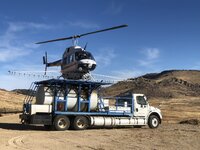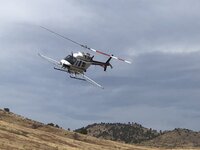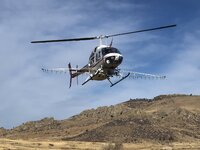I've been doing cheatgrass research and control for the past 30ish years! Cheatgrass is an invasive winter annual grass that reproduces from seed. The seed life of cheatgrass is 3 to 5 years. I wasn't too excited about cheatgrass control until the past few years. Several professors at universities across the Western US have tested Rejuvra (formerly Esplanade). We figured out that cheatgrass control with this herbicide outlasts the life of cheatgrass seed in the soil!
Rejuvra releases native forb and shrub species that mule deer depend upon for their livelihood. The research I've conducted in Colorado shows that mountain mahogany, antelope bitterbrush, winterfat, rabbitbrush, sumac, and other browse species annual growth is 5 to 10 x greater where we control cheatgrass! Not only do mule deer benefit from the release of natives shrubs and forbs but also pollinators, ground nesting birds, and a long list of other wildlife. If you have sage grouse in your area....they would definitely benefit!
We also discovered that cheatgrass litter breaks down super fast. In most cases it decomposes in just 1 year. Cheatgrass litter is like kindling that fuels high intensity wildfires. Where we eliminated cheatgrass there is more of a mosaic burn that doesn't kill the browse species that mule deer rely on. I've been monitoring some large areas where we had wildfires last year and this is definitely the case. Cheatgrass returns quickly in burned areas and as mentioned in the article above, devastating wildfire frequency dramatically increases.
With that said, there currently are large cheatgrass control projects taking place with Rejuvra across the Western US. We are doing large scale treatments via helicopter in Colorado, Wyoming, and elsewhere. Not only does Rejuvra control cheatgrass but other extremely tough to control annual grass species such as ventenata, medusahead, and feral rye.
Rejuvra recently got grazing on it's label. If you have cattle, we've found that perennial grass biomass increases 2 to 10x where we control cheatgrass.
If you have any questions in regard to cheatgrass or know a land manager that would like to improve mule deer and wildlife habitat invaded by cheatgrass please contact me.
Rejuvra releases native forb and shrub species that mule deer depend upon for their livelihood. The research I've conducted in Colorado shows that mountain mahogany, antelope bitterbrush, winterfat, rabbitbrush, sumac, and other browse species annual growth is 5 to 10 x greater where we control cheatgrass! Not only do mule deer benefit from the release of natives shrubs and forbs but also pollinators, ground nesting birds, and a long list of other wildlife. If you have sage grouse in your area....they would definitely benefit!
We also discovered that cheatgrass litter breaks down super fast. In most cases it decomposes in just 1 year. Cheatgrass litter is like kindling that fuels high intensity wildfires. Where we eliminated cheatgrass there is more of a mosaic burn that doesn't kill the browse species that mule deer rely on. I've been monitoring some large areas where we had wildfires last year and this is definitely the case. Cheatgrass returns quickly in burned areas and as mentioned in the article above, devastating wildfire frequency dramatically increases.
With that said, there currently are large cheatgrass control projects taking place with Rejuvra across the Western US. We are doing large scale treatments via helicopter in Colorado, Wyoming, and elsewhere. Not only does Rejuvra control cheatgrass but other extremely tough to control annual grass species such as ventenata, medusahead, and feral rye.
Rejuvra recently got grazing on it's label. If you have cattle, we've found that perennial grass biomass increases 2 to 10x where we control cheatgrass.
If you have any questions in regard to cheatgrass or know a land manager that would like to improve mule deer and wildlife habitat invaded by cheatgrass please contact me.



